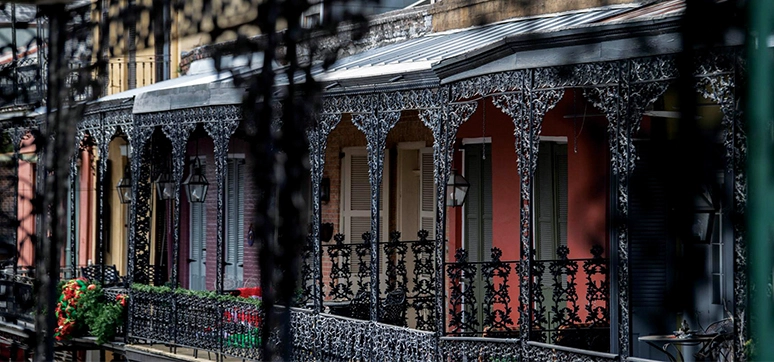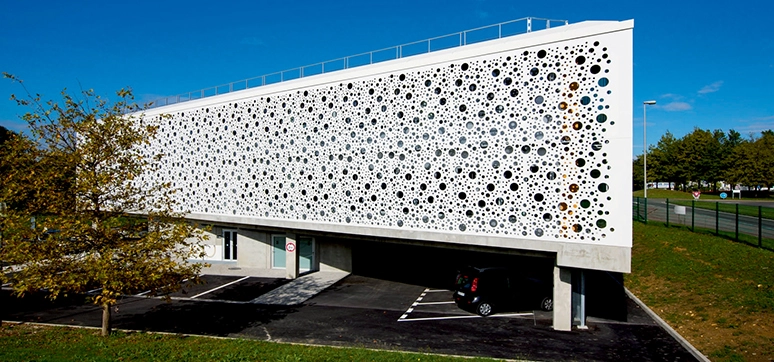The use of metal in building façades has a rich history dating back centuries, but its role in contemporary architecture is far from static. As we look toward the future, metal is poised to play a pivotal role in shaping the aesthetic, functional, and sustainable aspects of building exteriors. Let’s explore the evolving landscape of metal used in building façades, innovative materials, technologies, and sustainable practices that are driving this transformation.
The world of architecture is experiencing a transformative shift towards sustainability and innovation. Building façades, often considered the “face” of a structure, play a pivotal role in this evolution.
THE EVOLUTION OF METAL IN BUILDING FAÇADES
Before delving into the future, let’s briefly review the historical context. Metal has Façade Materials Use of Metal on Building Façades: Innovations & Sustainability has been a key player in building façades for centuries. From the ornate ironwork of 19th-century buildings to the sleek, modern aluminium-clad skyscrapers of the 20th century, metal has provided architects with a versatile canvas for their designs. However, it is in the 21st century that we see a remarkable shift in the application and role of metal in façades.
TECHNOLOGICAL ADVANCEMENTS
Digital Fabrication: One of the most significant drivers of change in metal façades is the advent of digital fabrication technologies. Computer-aided design (CAD) and computer-aided manufacturing (CAM) have revolutionised the way architects and engineers approach metal design. Complex geometric patterns, once challenging to produce, can now be fabricated with precision, opening doors to unprecedented design possibilities. Smart Façades: The future of metal façades lies in integration with smart building technologies. Metal panels can incorporate sensors, allowing the façade to adapt to environmental conditions. This includes dynamically adjusting shading elements based on sunlight or automatically ventilating to optimise energy efficiency. These adaptive façades enhance both aesthetics and sustainability.
INNOVATIVE MATERIALS
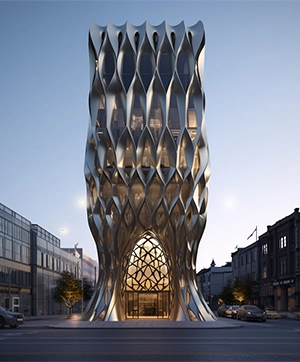
Nano-Coated Metals: The development of nanotechnology has brought forth a new generation of metal coatings that offer enhanced durability and functionality. Nano-coated metals are more resistant to corrosion, pollutants, and UV radiation, ensuring a longer lifespan for building façades. These coatings can also provide self-cleaning properties, reducing maintenance costs.
Biophilic Metal Façades: Biophilic design principles, which seek to connect buildings with nature, are gaining prominence. Metal façades can now incorporate living walls, vertical gardens, or even hydroponic systems. These green metal façades not only improve air quality but also contribute to the overall well-being of building occupants.
SUSTAINABILITY AND ENVIRONMENTAL IMPACT
The future of metal in building façades is intrinsically linked to sustainability. Sustainable practices are increasingly driving architectural decisions, and metal façades are no exception.
Energy Efficiency: Metal’s reflective properties can help reduce heat gain, lowering the need for air conditioning and thus energy consumption. Additionally, smart façades with integrated sensors can adjust shading to optimise natural lighting and temperature control.
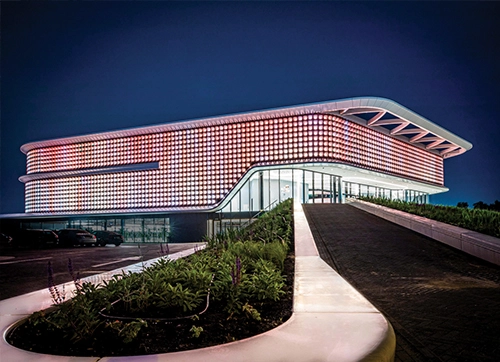
Recyclability: Metal is inherently recyclable, and advancements in recycling technologies make it an eco-friendly choice. Buildings with metal façades can be designed with future deconstruction and material reuse in mind, reducing their environmental footprint.
Solar Integration: Photovoltaic (PV) solar panels can be seamlessly integrated into metal façades, turning them into energy-generating surfaces. This not only reduces a building’s reliance on conventional energy sources but also adds an extra layer of visual appeal.
AESTHETIC POSSIBILITIES
While functionality and sustainability are essential, aesthetics remain a cornerstone of architectural design. The future of metal façades promises an array of creative possibilities:
Parametric Design: The integration of parametric design tools and computational algorithms is revolutionising the aesthetics of metal façades. Architects can now create intricate, geometric patterns that were once impossible to fabricate. This level of precision allows for designs that not only captivate the eye but also optimise solar orientation and shading, further enhancing a building’s energy efficiency.
Textured Finishes: Advanced fabrication techniques allow for a wide range of textured finishes on metal panels, adding depth and visual interest to façades. From brushed stainless steel to perforated aluminium, architects can choose finishes that align with their design vision.
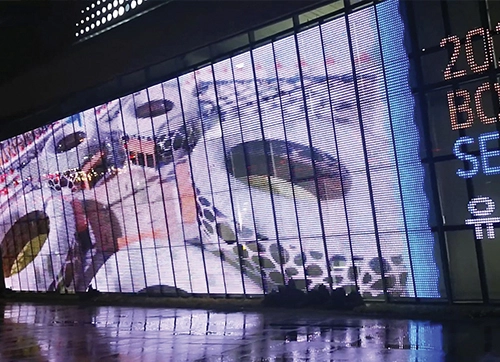
Colour Innovation: Modern metal coatings offer an extensive palette of colours, allowing architects to customise building exteriors to suit their creative concepts. Furthermore, these coatings can resist fading & chalking, maintaining their vibrant appearance over time.
Dynamic Lighting: LEDs and other dynamic lighting technologies can be integrated into metal façades, creating stunning visual displays. These dynamic façades can change colours or patterns, transforming the building’s appearance at night.
SHORT CASES: THE FUTURE IN ACTION
Let’s explore a few of real-world examples:
-
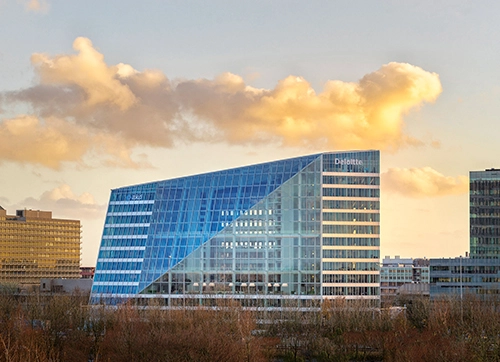
Aerial view of The Edge, Amsterdam, Netherlands The Edge, Amsterdam Deemed “The Greenest Building on Earth”, this pioneering office building features a metal+glass façade with integrated sensors, maximising natural light and energy efficiency. It showcases the potential of smart façades in reducing environmental impact while providing an inspiring work environment.
-
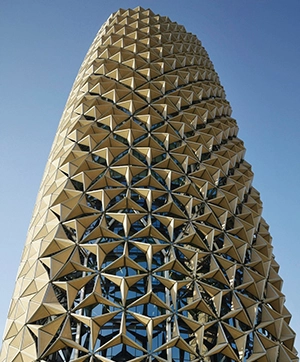
Dynamic façade of Al Bahar Towers, Abu Dhabi, UAE Al Bahar Towers, Abu Dhabi The defining feature of these towers lies in their shield-like covering composed of 2,000 metal+glass elements resembling umbrellas. These elements possess he capability to autonomously adjust, opening and closing in response to the changing sunlight levels. This ingenious design draws inspiration from the ‘Mashrabiya’, a geometric wooden lattice screen utilised in traditional Arabic architecture since the 14th century. The dynamic control of the Al Bahar Towers’ façade is overseen by a sophisticated building management system. This adaptable shading mechanism significantly mitigates interior heat gain attributable to sunlight, reducing it by approximately 50%.
- Municipal Offices of the Lacq Region, France The innovative façade design solution was achieved by employing pure white perforated metal panels to address the issue of excessive sunlight on the south side of the building. The design concept aimed to establish a solar shade that would effectively mitigate overheating while also permitting a controlled influx of natural light. The use of perforations featuring random circles with varying diameters results in a distinctive lighting effect within the building’s interior. This approach to the façade represents a harmonious blend of aesthetics, functionality, and cost-effectiveness.
-
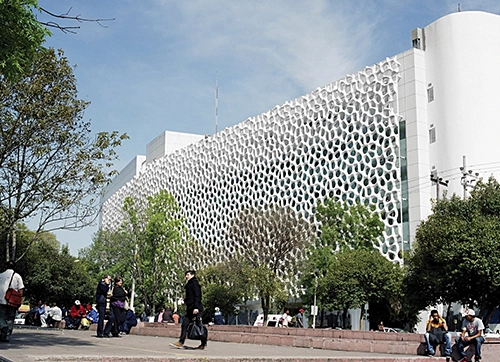
Air Purifying façade of The Torre de Especialidades, Mexico City, Mexico The Torre de Especialidades, Mexico City The Torre de Especialidades is a hospital building featuring a groundbreaking façade designed to purify the air. This remarkable feature is made possible through the use of titanium dioxide paint, developed by Elegant Embellishments, which coats the entire surface of the building’s exterior. By harnessing the power of sunlight in conjunction with titanium dioxide, harmful pollutants are transformed into benign compounds, primarily water. Beyond its ecological innovation, the façade of the building is also visually striking. Functioning as a standard skin system, it not only enhances the building’s aesthetics but also serves as an effective sun protection solution.
-
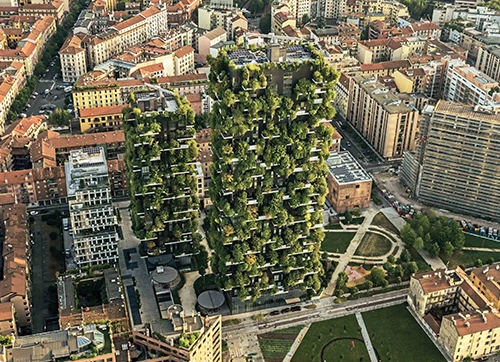
Green façade of the Bosco Verticale, Milan, Italy Bosco Verticale, Milan The Bosco Verticale, or Vertical Forest, is an example of biophilic design on a grand scale. Metal balconies host an array of trees and plants, not only beautifying the building but also contributing to urban biodiversity and improving air quality.
CONCLUSION
In the quest for sustainable, aesthetically pleasing, and technologically advanced building façades, metal emerges as a formidable contender. As we look ahead, we see a future where metal façades are more than just architectural elements; they are integral components of sustainable, responsive, and inspiring buildings.
The future of metal used in building façades is an exciting landscape where aesthetics, functionality, and sustainability converge. Technological advancements, innovative materials, and sustainable practices are reshaping the way architects approach metal façades, offering limitless design possibilities and enhancing the environmental and economic viability of buildings.
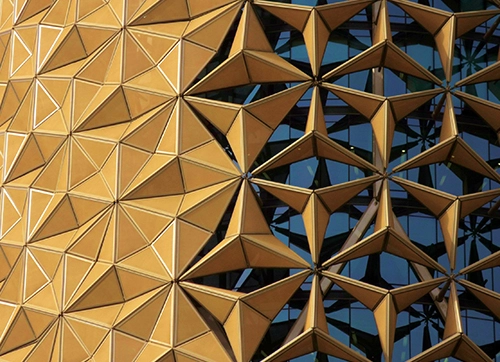
As architects and builders continue to push the boundaries of what is possible with metal, we can expect to see breathtaking façades that not only captivate the eye but also tread lightly on the planet. The future of metal in building façades is bright, promising a harmonious blend of artistry and sustainability in the architectural world.
Disclaimer: This article is for informational purposes only and does not constitute professional advice. The views and opinions expressed in this article are those of the author and do not necessarily reflect the official policy or position of Cinquefoil Design Lab LLC and/or Cynosure Innovations. Readers are encouraged to seek professional advice and conduct their research when making architectural decisions.
